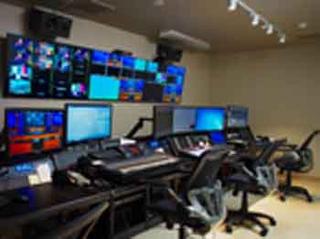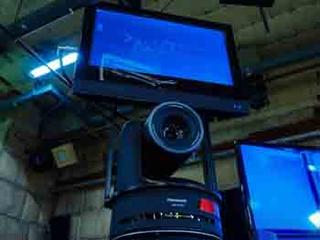California's KHSL Gets New HD SDI Start
CHICO, CALIF.--GOCOM Media's KHSL, the CBS affiliate serving the Chico-Redding, Calif. Market, is now operating out of upgraded HD production and master control facilities in a building in Chico, California it shares with KNVN, the local NBC affiliate (owned by K4 Media).
The complex project, which has now been fully operational since January, was designed and installed in November 2013 by systems integrator ABS. It gives both stations a tapeless workflow that can be leveraged across its newsgathering, studio production and postproduction activities, getting news to air faster and much more efficiently.
However, keeping the stations on the air during installation was not easy. Mark Siegel, president of ABS, called the KHSL project "the biggest 'little' project we've ever done."

KHSL-TV's new con troll room features a Ross Video Carbonite switcher, Grass Valley (Miranda) Kaleido multi-viewer, and Panasonic LCD monitors. "Coordination was critical," he said. "We needed to build and install an HD-SDI with embedded audio infrastructure without interfering with existing operations. It was definitely a challenge, but the end result is a much cleaner and more consolidated operation with a lot less cable."
Aaron "Mike" Roberts, director of engineering for the facility, is a bit more forthcoming. "It was a logistical nightmare and a very complicated move," he said. "We had three layers of build-out, and it all had to be worked around. We had to keep it running, yet build this new layer of digital. Overall, the project went great."
The native upgrade included new master control and production control rooms, plus new studio and ENG cameras, NLE systems, and the adoption of a tapeless workflow. The facility had layers of cables that could not be organized or removed until after the new HD SDI infrastructure was in place.
Roberts said the project provided a fresh start for the facility, from a technical point of view, which had previously transitioned from analog to digital SD, then to an HD/SD hybrid infrastructure. The new HD-SDI infrastructure includes embedded audio, which significantly reduced cable runs. A 4 RU 128x128 Utah Scientific router replaced four racks of system routing equipment. Other master control upgrades include Harmonic Omneon video servers controlled through NVerizon automation.
Get the TV Tech Newsletter
The professional video industry's #1 source for news, trends and product and tech information. Sign up below.
The new production control room is built around a Ross Carbonite production switcher and also features a Grass Valley (Miranda) Kaleido multi-viewer, Panasonic LCD monitors, Ross XPression CG, BlackStorm playout server, Yamaha LS9 audio board, Clear-Com intercom system and custom furniture from Martin & Ziegler. All newsroom edit systems were also upgraded to Adobe Premiere CS6 and are connected to an 18 TB SAN system.
For ENG field production, ABS replaced an aging group of tape-based camcorders with eight JVC GY-HM600 ProHD handheld camcorders with built-in 23x Fujinon lenses. Part of KHSL's new tapeless workflow, the cameras record HD footage to SDHC or SXHC media cards. Roberts said the new cameras were particularly effective shooting low-light footage, which was beneficial at the site of a local April 10 accident between a FedEx truck and school bus that gained national attention.

In the studio, five Panasonic AW-HE120 robotic PTZ HD cameras, each with a custom 13-inch LCD prompter system mounted on top that maintains the eye line of the news anchors. Rather than traditional studio cameras, ABS installed five Panasonic AW-HE120 robotic PTZ HD cameras, each with a custom 13-inch LCD prompter system mounted on top that maintains the eye line of the news anchors. According to Roberts, the system works very well and was "an innovative, inexpensive way" to update the studio's cameras.
During the project, ABS personnel took advantage of a vacant space on the second floor of the facility to relocate its analog news production. New racks and equipment were then installed and, once the HD infrastructure was in place, ABS created the new master control suite for KHSL and KNVN, and its three digital multicast channels.
The facility's original location for master control was designed to support a single station, so master control had been moved several years ago during an upgrade to accommodate multiple channels. However, technological innovations allowed ABS to return master control back in its original location. The new HD news production equipment was then installed in the space previously occupied by master control.
